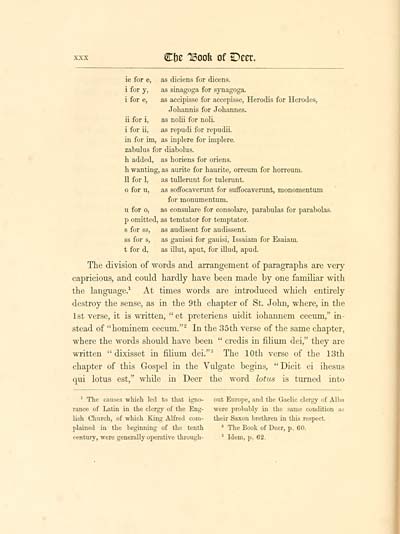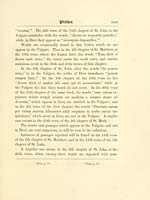Ossian Collection > Book of Deer
(44)
Download files
Complete book:
Individual page:
Thumbnail gallery: Grid view | List view

€f)C ISoofc of Deer.
ie for e, as diciens for dicens.
i for y, as sinagoga for synagoga.
i for e, as accipisse for accepisse, Herodis for Herodes,
Johannis for Johannes,
ii for i, as nolii for noli
i for ii, as repudi for repudii.
in for im, as inplere for implere.
zabulus for diabolus.
h added, as horiens for oriens.
h wanting, as aurite for haurite, orreuni for horreum.
11 for 1, as tullerunt for tulerunt.
o for u, as soffocaverunt for suffocaverunt, monomentum
for monumentum.
u for o, as consulare for consolare, parabulas for parabolas,
p omitted, as temtator for temptator.
s for ss, as audisent for audissent.
ss for s, as gauissi for gauisi, Issaiam for Esaiam.
t for d, as illut, aput, for illud, apud.
The division of words and arrangement of paragraphs are very
capricious, and could hardly have been made by one familiar with
the language. 1 At times words are introduced which entirely
destroy the sense, as in the 9th chapter of St. John, where, in the
1st verse, it is written, " et preteriens uidit iohannem cecum," in-
stead of "hominem cecum." 2 In the 35th verse of the same chapter,
where the words should have been " credis in filium dei," they are
written " dixisset in filium dei." 3 The 10th verse of the 13th
chapter of this Gospel in the Vulgate begins, "Dicit ei ihesus
qui lotus est," while in Deer the word lotus is turned into
1 The causes which led to that igno- out Europe, ami the Gaelic clergy of Alba
ranee of Latin in the clergy of the Eng- were probably in the same condition as
lish Church, of which King Alfred com- their Saxon brethren in this respect,
plained in the beginning of the tenth 2 The Book of Deer, p. 60.
century, were generally operative through- a Idem, p. 62.
ie for e, as diciens for dicens.
i for y, as sinagoga for synagoga.
i for e, as accipisse for accepisse, Herodis for Herodes,
Johannis for Johannes,
ii for i, as nolii for noli
i for ii, as repudi for repudii.
in for im, as inplere for implere.
zabulus for diabolus.
h added, as horiens for oriens.
h wanting, as aurite for haurite, orreuni for horreum.
11 for 1, as tullerunt for tulerunt.
o for u, as soffocaverunt for suffocaverunt, monomentum
for monumentum.
u for o, as consulare for consolare, parabulas for parabolas,
p omitted, as temtator for temptator.
s for ss, as audisent for audissent.
ss for s, as gauissi for gauisi, Issaiam for Esaiam.
t for d, as illut, aput, for illud, apud.
The division of words and arrangement of paragraphs are very
capricious, and could hardly have been made by one familiar with
the language. 1 At times words are introduced which entirely
destroy the sense, as in the 9th chapter of St. John, where, in the
1st verse, it is written, " et preteriens uidit iohannem cecum," in-
stead of "hominem cecum." 2 In the 35th verse of the same chapter,
where the words should have been " credis in filium dei," they are
written " dixisset in filium dei." 3 The 10th verse of the 13th
chapter of this Gospel in the Vulgate begins, "Dicit ei ihesus
qui lotus est," while in Deer the word lotus is turned into
1 The causes which led to that igno- out Europe, ami the Gaelic clergy of Alba
ranee of Latin in the clergy of the Eng- were probably in the same condition as
lish Church, of which King Alfred com- their Saxon brethren in this respect,
plained in the beginning of the tenth 2 The Book of Deer, p. 60.
century, were generally operative through- a Idem, p. 62.
Set display mode to: Large image | Transcription
Images and transcriptions on this page, including medium image downloads, may be used under the Creative Commons Attribution 4.0 International Licence unless otherwise stated. ![]()
| Early Gaelic Book Collections > Ossian Collection > Book of Deer > (44) |
|---|
| Permanent URL | https://digital.nls.uk/82539821 |
|---|
| Description | Selected books from the Ossian Collection of 327 volumes, originally assembled by J. Norman Methven of Perth. Different editions and translations of James MacPherson's epic poem 'Ossian', some with a map of the 'Kingdom of Connor'. Also secondary material relating to Ossianic poetry and the Ossian controversy. |
|---|
| Description | Selected items from five 'Special and Named Printed Collections'. Includes books in Gaelic and other Celtic languages, works about the Gaels, their languages, literature, culture and history. |
|---|

